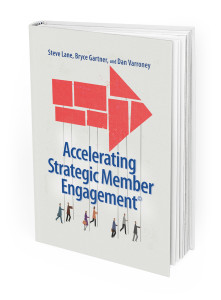Business Outcome Profile
Getting the final membership commitment is difficult for many Associations. Companies remain uncertain about the economic environment and as a result they remain hesitant when it comes to joining another Association. Despite market resistance, new member growth and positive financial reports are expected at board meetings. CEOs continue to face interesting challenges on the membership growth front.
Plato reminds us that “necessity is the mother of invention” and thankfully so. Utilizing member data, Associations can construct a more innovative game plan to grow new members. CEOs and Senior Managers will be pleased to learn, notwithstanding impediments, that new member growth is well within their reach.
Business Outcome Strength Profile
Developing an Association Member Business Outcome Profile reflecting the most active and participative companies is a powerful resource for CEOs seeking a path to new member growth:
- How connected are we to Member Business Outcomes?
- What types of companies/ sectors actively participate in the Association today?
- Which products, services and policy committees draw consistent participation from these sectors?
- What are the pain point reasons motivating current members to participate as actively as they are?
- Which prospect companies reside in the same companies/sectors as your most active members?
Associations can develop an effective list of prospects in the same companies/sectors as the most active members. Why? If the Member Business Outcome Profile shows strong support for the Association among existing members, it becomes more likely that prospects will be open to membership consideration.
Move Quickly
Having the benefit of data revealing strong support in key companies/sectors, new member recruitment should become an Association wide effort. Greater participation is a bellwether and Association CEOs should motivate all stakeholders to help achieve new member growth:
- Board Members. Share the Member Business Outcome Profile and strategy with the Board. They’ll want to know their business outcomes are being met. Ask them to be on the team and open doors for staff to meet with prospects. Express appreciation and acknowledge their help at Board meetings.
- Staff. Encourage staff throughout the Association to join the effort to grow membership. Keep them motivated through communication, share regular progress reports.
Business Outcome Profile
One Association achieved its first profitable year in almost five years utilizing a Business Outcome Profile. The following year they achieved the best growth performance in six years. Several other Associations doubled membership, achieved record sponsor performance and drove consistent 90% + retention performance.
“In the middle of difficulty lies opportunity” said Albert Einstein. The global economy, and economic uncertainty make it difficult for Associations to achieve their new member objectives. However, a Business Outcome Profile identifies strategies to to link the Association with memebr business outcomes and create more opportunity to achieve and even surpass new member growth objectives.
For a free copy of the “Accelerating Strategic Member Engagement” eBook, request your copy at www.potomaccore.com.







